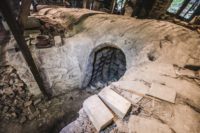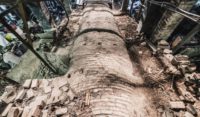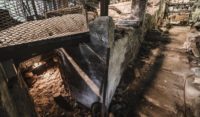 Hong Kong’s only complete dragon kiln is in danger of fatal damage, even demolition, from a plan to build public housing on its lot. Built in the 1940s, the Castle Peak Pottery Kiln in the city of Tuen Mun is designated by the Antiquities Advisory Board a grade three historic building, but that status is not sufficient to enforce its preservation. According to the grading standards, if a grade three site cannot be preserve due to practical considerations, “alternative means” are acceptable. Alternative means apparently include destruction, which makes the whole the designation something of a bad joke.
Hong Kong’s only complete dragon kiln is in danger of fatal damage, even demolition, from a plan to build public housing on its lot. Built in the 1940s, the Castle Peak Pottery Kiln in the city of Tuen Mun is designated by the Antiquities Advisory Board a grade three historic building, but that status is not sufficient to enforce its preservation. According to the grading standards, if a grade three site cannot be preserve due to practical considerations, “alternative means” are acceptable. Alternative means apparently include destruction, which makes the whole the designation something of a bad joke.
 The brick dragon kiln has a firing chamber 20 meters long that slowly slopes upward. It’s a traditional form that has been in use for thousands of years and is the reason China was able to produce stoneware and porcelain since distant antiquity that eluded the West until the 18th century. Dragon kilns are named after their long, tunnel form reminiscent of the body of a Chinese dragon. The shape dates back to the Shang dynasty (ca. 1600-1046 B.C.) when stoneware first began to be fired. It requires very high heat (1200C or higher), and the elongated, slender domed shape of the dragon kiln, built on a slope to capture rising heat, made it possible to achieve such high temperatures as well as to fire multiple pieces at once. Those early kilns were more modestly sized at between five and 12 meters, but over the centuries they grew to enormous dimensions, as much as 60 meters in length, dwarfing the one in Hong Kong.
The brick dragon kiln has a firing chamber 20 meters long that slowly slopes upward. It’s a traditional form that has been in use for thousands of years and is the reason China was able to produce stoneware and porcelain since distant antiquity that eluded the West until the 18th century. Dragon kilns are named after their long, tunnel form reminiscent of the body of a Chinese dragon. The shape dates back to the Shang dynasty (ca. 1600-1046 B.C.) when stoneware first began to be fired. It requires very high heat (1200C or higher), and the elongated, slender domed shape of the dragon kiln, built on a slope to capture rising heat, made it possible to achieve such high temperatures as well as to fire multiple pieces at once. Those early kilns were more modestly sized at between five and 12 meters, but over the centuries they grew to enormous dimensions, as much as 60 meters in length, dwarfing the one in Hong Kong.
 Because the kilns required a slope to fire pieces along their full length, almost all of them were built on hilly land in the countryside. City dragon kilns are rare, which makes Hong Kong’s sole example all the more worth preserving. The kiln is on a 1.7 acre lot that is one of five properties that the government wants to use to built 10,700 public housing apartments. Just over 1,000 of them would be built in a 40-storey high-rise at the kiln site on Hin Fat Lane. There’s a residential home for people with intellectual disabilities on the site that would have to be rebuilt elsewhere.
Because the kilns required a slope to fire pieces along their full length, almost all of them were built on hilly land in the countryside. City dragon kilns are rare, which makes Hong Kong’s sole example all the more worth preserving. The kiln is on a 1.7 acre lot that is one of five properties that the government wants to use to built 10,700 public housing apartments. Just over 1,000 of them would be built in a 40-storey high-rise at the kiln site on Hin Fat Lane. There’s a residential home for people with intellectual disabilities on the site that would have to be rebuilt elsewhere.
The Planning Department doesn’t seem to care about the kiln or the facility or about the wishes of the district council, for that matter. It’s all pretty shady.
[Tuen Mun district councilor Tam Chun-yin] said the district council vetoed the redevelopment plan involving five pieces of land in Tuen Mun last September and November, citing concern about transport with an influx of over 10,000 households.
“But the Planning Department went on to submit its plans to the Town Planning Board, and nothing could stop them after the board held a public forum in April,” he added.[…]
In a preliminary development review published last September, the Civil Engineering and Development Department anticipated that “ground-borne vibration, ground settlement and tilting due to construction works” might affect the kiln’s structural integrity.
The department recommended “a detailed geotechnical assessment and a condition survey” of the kiln before the work began.
[Wan Chai district councilor Clarisse Yeung Suet-ying] said: “So far we haven’t seen a detailed preservation plan for the kiln. Therefore we would like to urge the Town Planning Board to reconsider the plan submitted by the Planning Department to guarantee a full preservation.”
Yeung is the co-founder of the Hong Kong Dragon Kiln Concern Group, an organization of ceramic enthusiasts who have been working for a year to save the kiln from development. They launched an online petition on Tuesday, hoping to scrounge up enough signatures to give the Town Planning Commission pause before the period of public consultation ended. They got 1,815 in less than 24 hours, which is a testament to how meaningful the dragon kiln is to Hong Kong’s cultural heritage.
It might have to go a bit more viral than that in china to make a difference.
Hong Kong is suffering from an extreme shortage of housing. The middle classes live in micro apartments, the poor in so-called coffin homes. Pretty much nobody is happy with this situation. Politicians are just trying to meet the majority’s wishes for more housing and by now there are few easy choices to make anymore.